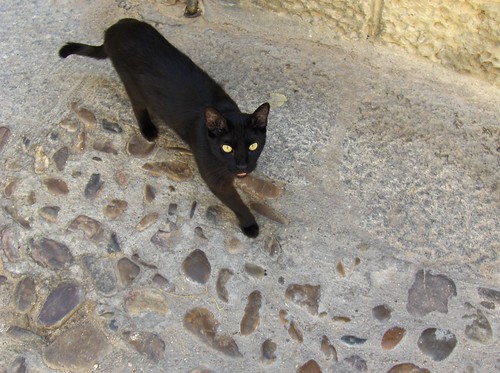From time to time I hear my imaginary reader (who lives inside my head and sometimes puts in an appearance under the pseudonym "plain people of Ireland") complain - "But, David, witty, fascinating and erudite though your blog might be, it gives short shrift to the visual arts."
Upon reflection, I find that there is a good deal of validity to this criticism. Accordingly, by special request, this post is dedicated completely to the visual arts.
http://www.miserychildren.com/
http://www.charlesparkerboggs.com/Site/Knobs.html
Remember, you asked for it!
Oh, OK, here's a one-stop site for you to browse as you see fit. It's where the two links above came from:
http://mocoloco.com/
Now, let's hope that will do it for the visual arts for at least another 5 months. Thank you very much.
Saturday, August 18, 2007
Does this post smell funny? (2)
It's been a while since we heard from our good friend Chandler Burr, perfume critic at the New York Times.
http://gaelstat.blogspot.com/2007/03/does-this-post-smell-funny.html
But, you will be relieved to know that a recent search revealed that he is still hard at work, churning out appalling prose at an amazing rate. Two recent examples:
Dirty is vastly underrated as a perfume aesthetic. There are, of course, several kinds of dirty. Exhibit A is Agent Provocateur, a lingerie concern that, like Victoria's Secret, professes to sell sex. But while Victoria's Secret is that great Middle American Walt Disney of sex, Agent is slightly grittier, dirtier. Or it professes to be; sex packaged by marketers tends to promise the real thing but is in fact so sterile you couldn't even catch the other person's cold. It's dirt without germs, an idea of intimacy without actually experiencing it. The surprise is that this turns out to be an excellent concept for a perfume. The brilliance of Agent Provocateur, the company's rather astonishing first perfume, is that it doesn't actually smell like unwashed panties. It's better than that: it just reminds you of them. It smells like crushed raspberries and black plums on hot skin. Expertly constructed by the perfumer Christian Provenzano, the juice lasts beautifully, diffuses perfectly and could raise the fertility rate in Manhattan without raising laundry bills. It's like a photo of a thong and cheeky ouverts. All image, no dirt.
link to the full article from which the above is taken (you may need to register, but it's free)
Oh, OK, here's one more:
Marc Jacobs recently put out a line of scents, most of which interpret fresh: Ivy, for example, is a lovely piece of olfactory sculpture by Richard Herpin that has the slightly alarming, mossy, humid, almost poisonous green odor of a hyperrealist photo by Mapplethorpe. Then there's Marc Jacobs Rain, which could, in theory, evoke the scent of static electricity from the lightning and silicate dust that a storm kicks up on the prairie, or even the smell of tropical rain on hot, green rot. Sadly, this fragrance is neither. This is a Calgon concept of rain, basically a kind of Febreze for humans.
To be fair, this article was dated April 1st
But taking aim at Chandler starts to feel mean-spirited, after a while. Too much like shooting fish in a barrel. I wonder if he is aware of the annual Bulwer-Lytton contest?
http://gaelstat.blogspot.com/2007/03/does-this-post-smell-funny.html
But, you will be relieved to know that a recent search revealed that he is still hard at work, churning out appalling prose at an amazing rate. Two recent examples:
Dirty is vastly underrated as a perfume aesthetic. There are, of course, several kinds of dirty. Exhibit A is Agent Provocateur, a lingerie concern that, like Victoria's Secret, professes to sell sex. But while Victoria's Secret is that great Middle American Walt Disney of sex, Agent is slightly grittier, dirtier. Or it professes to be; sex packaged by marketers tends to promise the real thing but is in fact so sterile you couldn't even catch the other person's cold. It's dirt without germs, an idea of intimacy without actually experiencing it. The surprise is that this turns out to be an excellent concept for a perfume. The brilliance of Agent Provocateur, the company's rather astonishing first perfume, is that it doesn't actually smell like unwashed panties. It's better than that: it just reminds you of them. It smells like crushed raspberries and black plums on hot skin. Expertly constructed by the perfumer Christian Provenzano, the juice lasts beautifully, diffuses perfectly and could raise the fertility rate in Manhattan without raising laundry bills. It's like a photo of a thong and cheeky ouverts. All image, no dirt.
link to the full article from which the above is taken (you may need to register, but it's free)
Oh, OK, here's one more:
Marc Jacobs recently put out a line of scents, most of which interpret fresh: Ivy, for example, is a lovely piece of olfactory sculpture by Richard Herpin that has the slightly alarming, mossy, humid, almost poisonous green odor of a hyperrealist photo by Mapplethorpe. Then there's Marc Jacobs Rain, which could, in theory, evoke the scent of static electricity from the lightning and silicate dust that a storm kicks up on the prairie, or even the smell of tropical rain on hot, green rot. Sadly, this fragrance is neither. This is a Calgon concept of rain, basically a kind of Febreze for humans.
To be fair, this article was dated April 1st
But taking aim at Chandler starts to feel mean-spirited, after a while. Too much like shooting fish in a barrel. I wonder if he is aware of the annual Bulwer-Lytton contest?
La prensa rosa
Regular readers of this blog will know that, this weekend, I am deep in the midst of books with such exciting titles as "Dificultades del español para hablantes de inglés", in preparation for next Friday's DELE intermedio exam. However, I wouldn't want to convey the impression that all is dullness and boredom (¿"ser" y "estar", "por" y "para", anyone?). For instance, thanks to my delightful teacher, Gloria, I have materials such as the following, to augment my studies:

Although right now I have no clue as to who Raquel and Tony might be, or who the other woman threatening the Iglesias marriage is, you can bet your bottom peseta that, before the weekend is over, I will know all about these topics.
And, of course, that I will be more than happy to share. Because readers of this blog deserve the entire, gossipy, truth.

Although right now I have no clue as to who Raquel and Tony might be, or who the other woman threatening the Iglesias marriage is, you can bet your bottom peseta that, before the weekend is over, I will know all about these topics.
And, of course, that I will be more than happy to share. Because readers of this blog deserve the entire, gossipy, truth.
Friday, August 17, 2007
Let's get baked! (2)
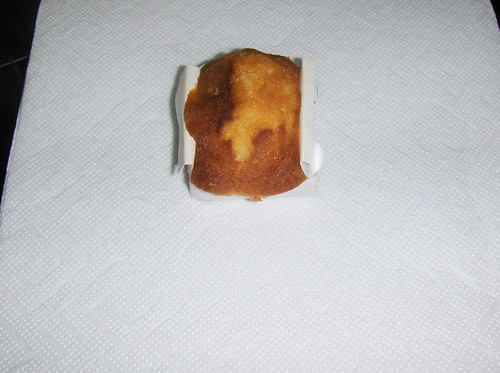
Recall the test items. Directly above and below, the magdalena, filled with apricot jam.


And, directly above and below, the bizcocho, fresh from those good folks at the Panadería of "El Arból"

Updated Materials and Methods:
Before getting to the exciting conclusion, I should explain that an impromptu decision was made today to quadruple the size of the study, enlisting the aid of 3 further test subjects to participate in the experiment. To protect the anonymity of the participants, let's just say that one was French, one was Spanish, and the third additional taster was from Crete. Thus, results below represent the view of a multinational research team, including 3 men and 1 woman.
Tasting was again conducted in a manner which balanced across tasting sequences (MB and BM), with each sequence being represented twice in the testing. Informed consent of the subjects was obtained orally, rather than in written form, a possible minor breach of the Helsinki protocols governing human experimentation. Subjects were, however, given adequate warning of potential risks of participation, and adequate fluid supplies were on hand at all times. Testing was conducted in a local Don Quijote classroom, in direct violation of school rules forbidding eating in class, but with the willing collusion and implicit approval of the teacher-participant present throughout the experiment.
Each item was scored, using an integer scale from 1 (inedible) to 5 (food of the gods), on each of the following four dimensions:
- Sabór (flavor)
- Textura (texture)
- "Mouthfeel" (mouthfeel)
- "Abuela" (rating relative to your grandmother's baked goods)
As both items received identical scores on the dimension "abuela", this has been omitted from the final scores reported below, due to its lack of discriminatory power (though see the "Discussion of results" section below).
Results: (total scores across all 4 testers)
Magdalenas relladas: flavor - 12; texture - 12; mouthfeel - 8. Total = 32
Bizcocho: flavor - 12; texture - 11; mouthfeel - 13. Total = 36
Discussion of results:
With bizcocho appearing as the clear winner, it might seem that congratulations are in order for the good bakers at the Panadería of "El Arból". However, two caveats must be mentioned, which make their victory something less than a complete triumph.
- Uniformly, all tasters gave both items a rating of 1 on the "abuela" dimension. Thus, the relative merits of the bizcocho need to viewed in the context of its complete lack of palatability when measure in terms of home-made deliciousness.
- From the second bizcocho picture shown above, it can be seen that the item in question comes packaged with a little strip of paper at the bottom. It needs to be mentioned that during the experiment, one of the tasters (me) initially neglected to remove the paper in question, resulting in the inadvertent mastication of same. Upon noticing the error, and removing the paper, there was no discernible difference in the overall tasting experience.
This second observation places the overall taste-test in its appropriate context. Which is to say that, even in the case of these high-end Spanish baked goods, you are unlikely to notice much difference between eating the products in question and chowing down on a nice ream of paper.
Unfortunately, that is where we shall have to leave things for this evening. Your faithful correspondent has a date with "Dificultades del español para hablantes de inglés", a book every bit as riveting as the title suggests:
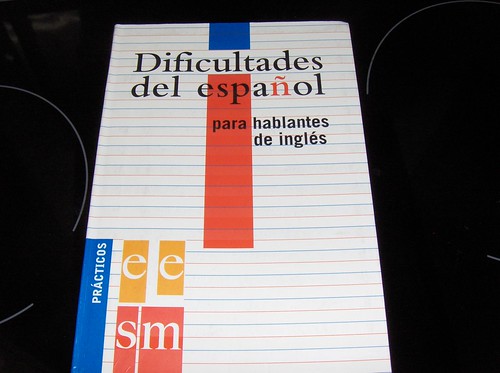
Thursday, August 16, 2007
Let's get baked (part 1)
In one of my earlier posts here in Salamanca, I made some rather disparaging remarks about the quality of Spanish baked goods (the phrase "silica gel" was used as a reference comparison, for instance). Upon mature reflection, and because I had a little time on my hands (by the time I made up my mind to go see "Ratatouille", it had already gotten too late), I decided that such snap judgements are not in keeping with the fair and balanced tone to which this blog aspires. So, just now, right here in the delightful kitchen in the Don Quijote piso de lujo, I mounted an impromptu "Operation eSpanish baked goods", in an effort to get a better handle on this thorny, but important question. In the spirit of truthiness in reporting, I now share with you the results.
Materials and Methods:
In the local supermarket "El Arból", two separate types of baked goods were purchased, each at the higher end of the price scale, thereby allowing maximum opportunity to score highly on the Culinary Institute of America's baked good deliciousness index (CIA-BGDI). The CIA-BGDI is a comprehensive, internationally accepted, statistically validated (Kronbach's alpha = 0.82) scoring scheme which rates baked goods on several orthogonal factors such as appearance, palatability, "mouthfeel", desiccation quotient, among others (all identified by the latest factor analytic methods).
The products selected for testing were the following.
SUPER brand magdalenas rellenas de mermeleda de albaricoque (M):

Bizcocho con frutas, from la Panadería de "El Arból" (B)

Readers are asked to excuse the amateur quality of the photos shown here: locating an experienced food wrangler was beyond the budget of this study.
Limited resources dictated use of an N=1 design; however, standard experimental design methods were implemented to maximize the integrity of study results. Specifically, tasting was conducted in a manner which balanced across product sequence, with each sequence (MB and BM) being used once. Further replication was deemed potentially injurious to the participant's health.
Participating subject in the N=1 design was a healthy, 50-year old Irish male, deemed sufficiently acclimated to the vagaries of eSpanish diet by virtue of 5 months' residence on the Iberian peninsula. Copious supplies of mineral water were on hand, in case of SDS (sudden desiccation syndrome) onset, and as a palate cleanser between tasting sequences.
Unfortunately, results of this pioneering study will have to wait until the next post, as the study subject/principal investigator has homework to do. Tune in tomorrow, for the exciting conclusion. The results may shock you!
Materials and Methods:
In the local supermarket "El Arból", two separate types of baked goods were purchased, each at the higher end of the price scale, thereby allowing maximum opportunity to score highly on the Culinary Institute of America's baked good deliciousness index (CIA-BGDI). The CIA-BGDI is a comprehensive, internationally accepted, statistically validated (Kronbach's alpha = 0.82) scoring scheme which rates baked goods on several orthogonal factors such as appearance, palatability, "mouthfeel", desiccation quotient, among others (all identified by the latest factor analytic methods).
The products selected for testing were the following.
SUPER brand magdalenas rellenas de mermeleda de albaricoque (M):

Bizcocho con frutas, from la Panadería de "El Arból" (B)

Readers are asked to excuse the amateur quality of the photos shown here: locating an experienced food wrangler was beyond the budget of this study.
Limited resources dictated use of an N=1 design; however, standard experimental design methods were implemented to maximize the integrity of study results. Specifically, tasting was conducted in a manner which balanced across product sequence, with each sequence (MB and BM) being used once. Further replication was deemed potentially injurious to the participant's health.
Participating subject in the N=1 design was a healthy, 50-year old Irish male, deemed sufficiently acclimated to the vagaries of eSpanish diet by virtue of 5 months' residence on the Iberian peninsula. Copious supplies of mineral water were on hand, in case of SDS (sudden desiccation syndrome) onset, and as a palate cleanser between tasting sequences.
Unfortunately, results of this pioneering study will have to wait until the next post, as the study subject/principal investigator has homework to do. Tune in tomorrow, for the exciting conclusion. The results may shock you!
Wednesday, August 15, 2007
Postcard from Salamanca
Two postcards, actually:

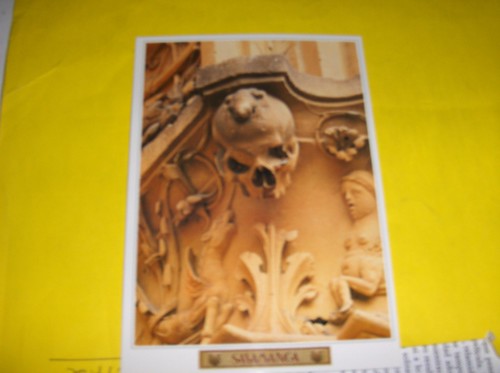
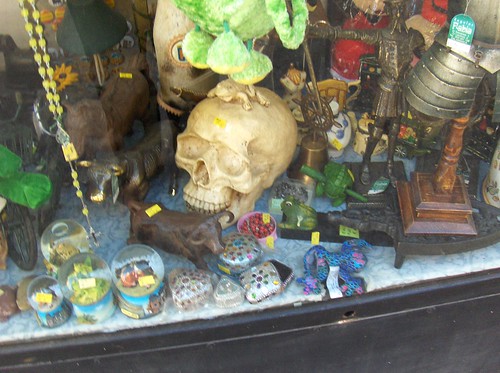

Hidden among the intricate carvings on the facade is a small frog perched atop a skull. Legend has it that in order to be successful in one's exams one must seek out the location of the frog without help from anyone else. I managed to do so this my first week here, thereby increasing my confidence about my chances for success in my exam next week.
This legend is the reason that frog souvenirs are ubiquitous in Salamanca. The frog is to this city what the bear is to Madrid.
fadeout to the sound of disgruntled ursine growling ...

Any person who steals, embezzles, or otherwise carries away any book, pergament or paper from this library will be excommunicated, without possibility of absolution until full restitution has been made.



Hidden among the intricate carvings on the facade is a small frog perched atop a skull. Legend has it that in order to be successful in one's exams one must seek out the location of the frog without help from anyone else. I managed to do so this my first week here, thereby increasing my confidence about my chances for success in my exam next week.
This legend is the reason that frog souvenirs are ubiquitous in Salamanca. The frog is to this city what the bear is to Madrid.
fadeout to the sound of disgruntled ursine growling ...
Tuesday, August 14, 2007
Checking in
This post is just to say that, while I was neglecting to blog today, I was nonetheless gainfully employed, augmenting my hours spent engaged (one way or another) with the intricacies of the exciting, but challenging Spanish language. Today may have set a record, as my total came to more than 12 consecutive hours, to wit:
The plain people of Ireland: That's it!??? That's your entire post!??? This is getting ridiculous. Why not just post your laundry list and have done with it?
The management: Certainly, if you would like.
The plain people of Ireland: Oh, pull yourself together and get a grip. That was just a joke, for God's sake.
The management: Well, not every post here can be Pulitzer material, you know. But perhaps tomorrow's Feast of the Assumption (a local holiday) will bring fresh inspiration. I have a date with el estilo indirecto (indirect speech) and its associated bewitching panoply of changes in verb tenses and moods. That's always good for a few laughs.
The plain people of Ireland: God, why do we even bother. Consider yourself on notice, bucko!
The management: There is no need for that kind of tone. This is a civil blog. But I promise to be more scintillating tomorrow. Meanwhile, here is a picture of eThpain's noble king, Carlos V.
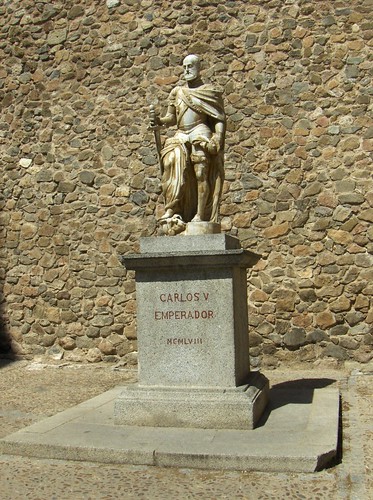
- Grammar classes : 4 hours
- Conversation class : 2 hours
- El País : 1 hour
- Watching Ridley Scott's "1492" (doblado in eThpanish, so this counts) : 2 hours 20 minutes
- Drinking with classmates : 2 hours
- Watching appalling eThpanish TV : 45 minutes
The plain people of Ireland: That's it!??? That's your entire post!??? This is getting ridiculous. Why not just post your laundry list and have done with it?
The management: Certainly, if you would like.
The plain people of Ireland: Oh, pull yourself together and get a grip. That was just a joke, for God's sake.
The management: Well, not every post here can be Pulitzer material, you know. But perhaps tomorrow's Feast of the Assumption (a local holiday) will bring fresh inspiration. I have a date with el estilo indirecto (indirect speech) and its associated bewitching panoply of changes in verb tenses and moods. That's always good for a few laughs.
The plain people of Ireland: God, why do we even bother. Consider yourself on notice, bucko!
The management: There is no need for that kind of tone. This is a civil blog. But I promise to be more scintillating tomorrow. Meanwhile, here is a picture of eThpain's noble king, Carlos V.

Sunday, August 12, 2007
Congratulations!
If you are reading this, you may just be the 2500th visitor* to this blog. Current total stands at 2497, at the time of this posting.
* since the counter started, that is.
* since the counter started, that is.
PAGE 2000
PAGE in the header for this post refers to the "Population Approach Group in Europe", a group of European scientists (pharmacokineticists for the most part) involved in applying the principles and methods of population pharmacokinetic(PK) and pharmacodynamic (PD) modeling to real-world problems in drug development. With me so far? Keep going, it gets better after this, I promise.
Well, because of certain activities in my former life, more specifically, the book I co-authored with my good friend Marie Davidian, (link to the book) I am (and probably will remain, for as long as I live) inextricably linked to the topic of population PK and PD modeling. Thus, it was my honor to be invited to participate as a speaker in the June, 2000 meeting of the PAGE group, which was held in Salamanca. (link to notice of the PAGE 2000 meeting). So, you see, I do have a previous history with Salamanca, about which I've been holding out on you a little.
The conference was immensely enjoyable: it was an honor to have been invited, and I have nothing but the fondest memories of the event, and of Salamanca during that time. My favorite memory is the following. My flight into Madrid airport arrived at around 6pm, which meant I ended up taking the "special conference bus" from the airport, which left at 10pm. There were only about six people on the bus, it was late and I was completely exhausted by then. I vaguely remember passing through the darkened Spanish countryside, perking up briefly at signs of Ávila, then relapsing into exhausted, fitful sleep. When I woke up again, four of the other passengers had mysteriously vanished. The only two people remaining on the bus were one of the other speakers, Jean-Louis Steimer, whom I knew slightly from a previous professional conference, and I. (note: although Jean-Louis doesn't show as a presenter, I'm pretty sure it was he.) The bus kept turning into narrower and narrower streets, until eventually the bus-driver, with an internationally recognizably expression of disgust, just stopped the bus and signalled to us that we had arrived at our destination. Before we had time to gather our wits, we found ourselves on the street, with our bags, watching as the bus vanished into the distance again.

We were right outside the entrance shown above, though both iron doors were completely closed, and the street was dark and deserted. I think both of us had imagined that the conference lodging would consist of some kind of modern, Holiday-Inn-like hotel and there was nothing even remotely resembling such accommodation in sight. We walked up and down the street for a bit, vainly trying to decipher the street name in the dark, desperately seeking in our bags for the destination address, which we eventually located. But, not a person in sight, and nothing but the huge stone walls and medieval iron doors of the university entrance, not that we were able to recognize it as such, given our state of confusion.
Just as we were about to give in to despair, there wandered into view one of the strangest pairs one could imagine - an elderly Spanish gentleman and his wife, very obviously upper middle class, both dressed to the nines, strolling along the street as if it were 9 pm rather than 1 am. They appeared to be giving us a wide berth, but since they were the only visible link to humanity, we fell on them beseechingly, showing them the address we were seeking, and asking them to help. Then, in a scene worthy of Buñuel, the gentleman looked us up and down, looked at the paper with the address, looked us up and down again, and shook his head dismissively, as he delivered himself of the following utterance:
"Yes, it is true that there are accommodations at this address", gesturing vaguely towards the building behind us. "But these accommodations are only for very important people."
And he handed us back the paper firmly, making it perfectly clear that we in no way qualified, in his mind, as the caliber of person who might expect to be lodged there. He and his lovely wife continued on their way, ignoring our protestations that, hey, we were important people....
What to do? At least he had confirmed that we were outside the correct building. So we set to examining the fortress-like entrance a little more closely and finally noticed a porter's bell off to one side (which had to be rung by pulling on it). Two minutes later, a sleepy and noticeably grumpy porter was opening the huge iron door to give us access to our accommodation inside. Regardless of our travel-weary, disheveled appearance, our passports were enough to convince him that we were, indeed, the eminent speakers featured on the program.
So that's my abiding memory of my first trip to Salamanca, in June 2000.
Your (very important) correspondent in Castilla y León.
Well, because of certain activities in my former life, more specifically, the book I co-authored with my good friend Marie Davidian, (link to the book) I am (and probably will remain, for as long as I live) inextricably linked to the topic of population PK and PD modeling. Thus, it was my honor to be invited to participate as a speaker in the June, 2000 meeting of the PAGE group, which was held in Salamanca. (link to notice of the PAGE 2000 meeting). So, you see, I do have a previous history with Salamanca, about which I've been holding out on you a little.
The conference was immensely enjoyable: it was an honor to have been invited, and I have nothing but the fondest memories of the event, and of Salamanca during that time. My favorite memory is the following. My flight into Madrid airport arrived at around 6pm, which meant I ended up taking the "special conference bus" from the airport, which left at 10pm. There were only about six people on the bus, it was late and I was completely exhausted by then. I vaguely remember passing through the darkened Spanish countryside, perking up briefly at signs of Ávila, then relapsing into exhausted, fitful sleep. When I woke up again, four of the other passengers had mysteriously vanished. The only two people remaining on the bus were one of the other speakers, Jean-Louis Steimer, whom I knew slightly from a previous professional conference, and I. (note: although Jean-Louis doesn't show as a presenter, I'm pretty sure it was he.) The bus kept turning into narrower and narrower streets, until eventually the bus-driver, with an internationally recognizably expression of disgust, just stopped the bus and signalled to us that we had arrived at our destination. Before we had time to gather our wits, we found ourselves on the street, with our bags, watching as the bus vanished into the distance again.

We were right outside the entrance shown above, though both iron doors were completely closed, and the street was dark and deserted. I think both of us had imagined that the conference lodging would consist of some kind of modern, Holiday-Inn-like hotel and there was nothing even remotely resembling such accommodation in sight. We walked up and down the street for a bit, vainly trying to decipher the street name in the dark, desperately seeking in our bags for the destination address, which we eventually located. But, not a person in sight, and nothing but the huge stone walls and medieval iron doors of the university entrance, not that we were able to recognize it as such, given our state of confusion.
Just as we were about to give in to despair, there wandered into view one of the strangest pairs one could imagine - an elderly Spanish gentleman and his wife, very obviously upper middle class, both dressed to the nines, strolling along the street as if it were 9 pm rather than 1 am. They appeared to be giving us a wide berth, but since they were the only visible link to humanity, we fell on them beseechingly, showing them the address we were seeking, and asking them to help. Then, in a scene worthy of Buñuel, the gentleman looked us up and down, looked at the paper with the address, looked us up and down again, and shook his head dismissively, as he delivered himself of the following utterance:
"Yes, it is true that there are accommodations at this address", gesturing vaguely towards the building behind us. "But these accommodations are only for very important people."
And he handed us back the paper firmly, making it perfectly clear that we in no way qualified, in his mind, as the caliber of person who might expect to be lodged there. He and his lovely wife continued on their way, ignoring our protestations that, hey, we were important people....
What to do? At least he had confirmed that we were outside the correct building. So we set to examining the fortress-like entrance a little more closely and finally noticed a porter's bell off to one side (which had to be rung by pulling on it). Two minutes later, a sleepy and noticeably grumpy porter was opening the huge iron door to give us access to our accommodation inside. Regardless of our travel-weary, disheveled appearance, our passports were enough to convince him that we were, indeed, the eminent speakers featured on the program.
So that's my abiding memory of my first trip to Salamanca, in June 2000.
Your (very important) correspondent in Castilla y León.
Q-words
- codorniz: quail (the noun, not the verb)
- membrillo: quince jelly
- graznar: quack (the verb)
- matasanos: quack (the noun)
The plain people of Ireland: This is a very lazy idea for a post, wouldn't you say?
The management: Possibly so, but still not without its uses. For instance, on the culinary front, knowledge of the word codorniz might save people from ordering the quail salad (all those crunchy, spitty little bones). And the word membrillo proves essential if you want one of the best ice-creams in town, the odd-sounding but delicious helado parmesano membrillo, available at that heladería over on the Plaza Mayor, the one which always has a long queue (cola).
Hyperbole
Recently, in a discussion over on the Table Talk section of www.Salon.com, I had reason to sum up my views on the subject of hyperbole in a single sentence. Which, as this blog is about sharing, I reproduce below:
I'd rather die bleeding in a gutter, with mutant rats gnawing at my intestines and Teletubbies singing the collected works of Anne Coulter to me as I expired, than live in a world without hyperbole.
I'd rather die bleeding in a gutter, with mutant rats gnawing at my intestines and Teletubbies singing the collected works of Anne Coulter to me as I expired, than live in a world without hyperbole.
City on a hill
Yesterday, I participated in a day excursion to Toledo, organized by the school. So it seems necessary to devote a blog entry to the trip. But what to say, really? Frankly, I found it a little disappointing, and feel somewhat guilty that this is the case (after all, I should count my blessings that I'm here, right?). But it would be a downright falsehood to say that I found the city enchanting. According to our guide (Javiér, one of the sweeter teachers at school), the big selling point is the mixture of Judaic, Moorish, and Christian cultures throughout the history of the city, and evident in its architecture. Which is fine, except that the same mixture is evident throughout Andalucía, so this invites an inevitable comparison with Sevilla. A comparison in which Toledo is doomed to come in a very poor second.
Here are some representative pictures:
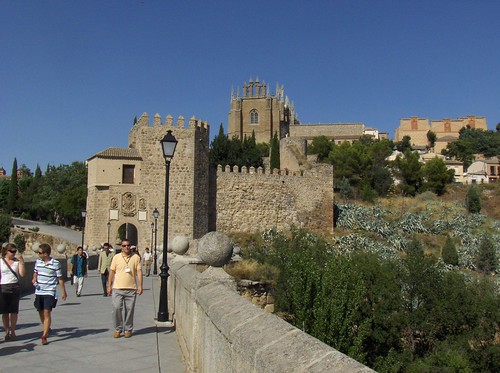
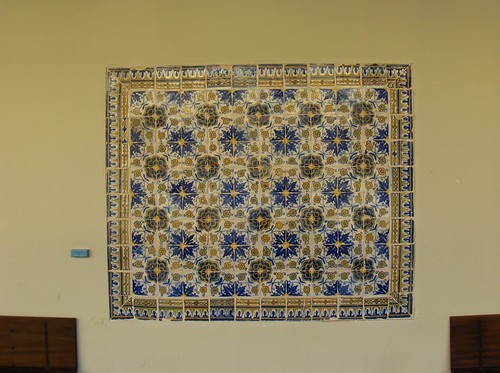

I think that the other thing which contributed to my definite lack of enthusiasm for the city was the undisguised rapacity of the local merchants and restaurateurs, as far as mulcting visitors to the city was concerned.
My passion for Sevilla continues unabated. Castilla-La Mancha will have to work harder to dislodge Sevilla from top place in my heart. As I said, I feel slightly guilty that this post is not more positive, but there is presumably no point in feigning enthusiasm. If nothing else, this blog is dedicated to truthiness in reporting.
Here are some representative pictures:



I liked the fact that they had a street named in honor of the other Toledo.
I think that the other thing which contributed to my definite lack of enthusiasm for the city was the undisguised rapacity of the local merchants and restaurateurs, as far as mulcting visitors to the city was concerned.
My passion for Sevilla continues unabated. Castilla-La Mancha will have to work harder to dislodge Sevilla from top place in my heart. As I said, I feel slightly guilty that this post is not more positive, but there is presumably no point in feigning enthusiasm. If nothing else, this blog is dedicated to truthiness in reporting.
Subscribe to:
Comments (Atom)
